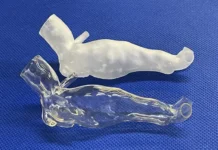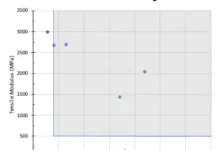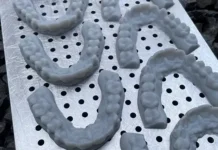By Amos Dudley, applications engineer, and Jon Bruner, director, digital factory, Formlabs

Modern high-precision lenses are fabricated using a process pioneered by ancient Egyptian artisans: glass, plastic or crystal is ground and polished using progressively finer abrasives until it meets a specified shape. Of course, state-of-the-art lens-making involves sophisticated computer numerical control (CNC) machinery and painstaking process control, but even these techniques are challenged by the task of grinding complex profiles, such as those of aspheric camera lenses and progressive eyeglass lenses.
This makes additive manufacturing an intriguing possibility for lens fabrication. 3D printing offers geometric freedom and the ability to quickly iterate lens designs without costly retooling.
However, one of the critical drawbacks of additive manufacturing is surface finish: 3D printing processes often produce visible layer markings and require abrasive or chemical finishing in order to obtain smooth surfaces.
It’s surprising, then, that the most promising finishing technique for 3D-printed lenses may, in fact, be additive. An applications engineer at Formlabs investigated several polishing techniques for the single-element lens in his 3D-printed 35mm camera. Photopolymer resin doesn’t respond to some other common plastic-polishing techniques, such as acetone-vapor polishing or flame polishing. So, he turned to mechanical polishing – this included hand-polishing a rough, 3D-printed lens for six hours with up to 12,000-grit pads, and automated polishing against a spherical form with abrasive slurry.

Neither process yielded a perfectly clear surface and, in any case, neither was capable of producing precise aspheric lenses. It turned out that both polishing techniques were outperformed by a final additive step: using a 3D-printed fixture, the engineer dipped each lens in liquid resin, which filled scratches and layer lines in the lens, and then cured the surface under a UV lamp. The surface tension of the final liquid layer created a completely smooth lens surface.
Here’s a detailed look at how the engineer set out to design and fabricate a 3D-printed camera lens using the Formlabs Form 2, a desktop inverted stereolithography machine that uses a 405 nm laser as the light source.
Step 1: Designing the lens, balancing distortion
Making a functional lens starts with proper lens design. Optical design software helps lens designers predict the behavior of a lens and the constraints the lens will place on a camera.
Professional lens designers use optics packages such as Zemax and Code V, but these programs can cost thousands of dollars. Free, open-source software, such as Optical Ray Tracer, is a suitable alternative for simple lens design.

Commercial camera lenses use multiple elements to correct for the optical distortions that commonly affect spherical lenses, such as spherical aberration, coma and field curvature. For the sake of simplicity, the 3D-printed camera is designed around a single spherical lens element.
Each side of a spherical lens is a section of a sphere with a given radius. Inserting the refractive index value for Clear Resin (1.5403) into Optical Ray Tracer shows that a symmetrical lens with a spherical radius of 50 mm focuses at approximately 47.5 mm from the center of the lens.
A single objective lens for a camera needs to balance optical power with distortion. A low-power, long focal length lens will have less distortion, but a narrow field of view. It is difficult to aim a camera if the field of view of its lens is too narrow. Reducing the aperture size helps to eliminate some coma distortion (Figure 1).

A good compromise between these factors is a focal length of 50 mm, which is wide enough to position a subject within the frame.
Once the lens is designed, it can be modeled in a CAD program. Since the lens is symmetrical, this is as simple as intersecting two 50 mm spheres at the right distance (Figure 2). The distance defines the radius and thickness of the lens but doesn’t radically affect the optics. The lens was designed to be 40 mm in diameter with a 2 mm cylindrical edge.
Step 2: 3D printing with the Form 2
In designing a 3D printing process for the lenses, it was important to consider different orientations and resolutions for printing. A lens printed horizontally may have layer line artifacts toward the center of the lens’s axis. A lens printed perfectly vertically may be subject to some distortion caused by the additive process.
The clearest lenses were printed at a 30° angle relative to the build platform, with supports placed only along the edge to prevent support marks on important lens surfaces.
Step 3: Addressing challenges in finishing

The engineer tried three methods of polishing lenses to optical clarity: manual sanding, automated sanding and dipping (Figure 3).
Attempt 1: manual sanding
This attempt used a range of sandpaper and micromesh pads with grits from 400 to 12,000, in increments of 200, and polished lenses to a very smooth finish. This was done slowly and with a lot of care to clean the lens between grit levels and to eliminate scratches from the previous level before moving on to the next.
At around 3,000 grit, SLA-printed lenses become glossy and very smooth to the touch. By 12,000 grit, they are reflective.
To make an optically clear lens, all layer lines need to be completely eliminated, which wasn’t possible by hand. Even though the lenses were smooth to the touch, reflections still appeared blurry, and micro-scratches were visible when holding the lenses at a shallow angle to the light.
The lens was clear as a magnifying glass, but as a focusing lens it wasn’t accurate enough.
Attempt 2: automated sanding
It was difficult to control the amount of material being sanded off in the early stages of hand sanding, where the bulk of the layer lines were being removed. The next step was to try an automated method for reducing layer lines.

The engineer designed and printed a lens polishing machine in hopes of reducing some of the error (Figure 4).
Within the lens machine, the lens is rotated against the inside of a dish with the same spherical radius. The dish also rotates, but off axis to the lens by 45 degrees, and at a different speed.
The lens is connected to a servo motor with a kinematic coupling that combines 3D-printed parts, springs and small rivets. The coupling keeps the lens firmly, but flexibly, pressed against the dish and allows it to “wobble” as it rotates. The dish holds a small amount of water and diamond lapping compound as an abrasive, and is made of the same clear resin as the lens.
The machine quickly reduced layer lines, but it couldn’t easily be used for the entire process. The dish would have to be replaced between polishing layers so grit wouldn’t be transferred to finer levels of polishing.
Attempt 3: dipping

While gluing some prints together, the engineer noticed that parts became significantly clearer when coated in a viscous material like epoxy, and decided to dip the lenses in liquid resin and then post-cure them under UV light. The viscous resin filled layers and scratches, forming a completely smooth surface (Figure 5).
Resin has a tendency to form bubbles when agitated, such as by dipping a lens, but these can be removed by turning the lens upside down over the resin tank and letting the resin gather and drain from the center.
The layer of resin should be as thin as possible while still eliminating layer lines. The last remaining bubbles were pulled off with a syringe, and the lens was post-cured completely under a UV lamp before dipping the other side.
The result

Resin-dipped lenses are extremely smooth, with clear and sharp surface reflections (Figure 6). This technique can be used for other SLA prints to produce an even smoother finish, although it does tend to reduce detail.
The dipping process also alters focal length slightly, so the engineer designed and printed a lens testing device. The device has screw threads that allow the lens to move closer and further from the imaging plane by turning the wheel, and experimentally check the focal distance of the lens.
References
- https://formlabs.com/blog/creating-camera-lenses-with-stereolithography/
- http://amosdudley.com/weblog/SLO-Camera
Jon Bruner is the director of the Digital Factory program at Formlabs, which aims to bring advanced digital fabrication to every industry. Before joining Formlabs, he oversaw O’Reilly Media’s publications and conferences related to electronics, manufacturing and industrial design. For more information, email bruner@formlabs.com. Amos Dudley is an applications engineer at Formlabs, where he tries to push the boundaries of functional 3D printing. With a background in digital design and architecture, Dudley previously worked at Ralph Appelbaum Associates as a 3D rendering and visualization artist. Contact him at amos@formlabs.com.






